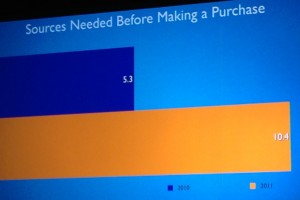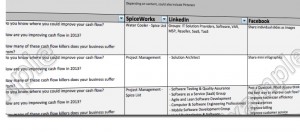Content Distribution: Why Publishing and Posting Aren’t Enough

If useful content is published but no one sees it, is it still useful?
There’s a growing epidemic among corporate content marketers and content producers. It’s a lack of a sharing. I’m not talking about lack of collaboration or not playing “nicey nice” in the sandbox. It’s about letting content die a slow, painful, pointless death after hitting that ever-loving “Publish” button.
Prospects actually WANT to see your (useful) content.
It’s probably no shock to you that there is a LOT of content out there. A daily avalanche, in fact. But that doesn’t mean you can’t compete for your prospects’ attention. In fact, it’s imperative that you do.
Mind you, this is different than the old days where you poured more dollars into advertising than the other guy. Today, it’s a matter of pouring on more *helpful* and *relevant* content. Help your prospect and they’ll take notice. Promise.

As Jay Baer noted in his recent keynote at Content Marketing World, buyers simply demand more content these days than ever before when making a decision: “In 2010, shoppers needed 5.3 sources of information before making a purchase decision. In 2011, just one year later, shoppers needed 10.4 sources before making a purchase decision.”
And we’re not just talking consumers here. B2B buyers are even thirstier for decision-making resources.
“B2B customers contact a sales rep only after 70% of the purchase decision has been made.”
Bottom Line: Useful content is the best pre-sales entity you’ll ever add to your team.
So, if helpful content goes unwritten, it’s a shame. But, if it exists and goes unseen — well, that’s just an outright crime.
Optimize for searching AND sharing.
Even before Google made its game-changing announcement that it will encrypt all search activity, many B2B marketers were taking the easy route of just matching content to keyword data. That “scientific” approach to getting content seen cuts its potential short — big time.
Yes, prospects will go to Google at some point during their search (usually to start). But, as with most complex B2B decision paths, they’ll eventually start to dig deep — and look well beyond the keywords.
They’ll delve into the bowels of your site. They’ll want examples, case studies and solutions they can identify with. They’ll have nagging questions that take them to specialized forums or LinkedIn groups. They’ll pay attention to online chatter among peers. And, they’ll absolutely abhor any sales talk as they try to weed through what’s best for their company or department.
Bottom line: If your publishing strategy starts with a few clicks and ends with a few pushes to the networks, you’re missing an enormous part of the picture.
Share, share, not alike.
Okay, so if you can’t just push content to a bunch of predefined LinkedIn groups, a few forums and some networks, what should you do?
To truly lock eyes with your customers, you must create an exhaustive sharing plan for every piece of content.
Let’s allow that to sink in…
Not just a sharing plan designed for the audience …but for each and every piece of content.
Why? Because the intent of each piece of content maps to completely different conversations.
Let’s take for example, Carl…
Carl is the lead developer at a healthcare chain tasked with updating the chain’s automated phone system. Carl is not a Customer Care guy. Not even close.
- Carl has to start the ball rolling — but feels “blinded” by his ignorance. His overworked Customer Care counterpart doesn’t know where to start either. After all, this is a technical decision, right?
- Carl starts scouring the web, learns a bit about the “big picture” of automated systems. He then becomes overwhelmed by the “it depends” answer he keeps getting.
- Carl decides to start asking around. He heads to his favorite IT forums, Developer boards and LinkedIn Groups.
- Carl poses the question, “We’re looking to switch from our 1985 Acme Voice Systems to a more updated system. Does anyone have advice or ideas on where to start?”
Eureka! This would be a superb time to respond with your publication: 10 Things You Must Know Before Choosing Your Customer Service Automation, right?
Note that word: respond.
But alas, your team posted the publication on a little corner of your website. And two of your salespeople (who Carl doesn’t know) posted to their LinkedIn status updates one day. Oh…and a link is on your company’s Facebook page.
The mere fact that your content is useful and ready to rock isn’t enough. Your content will never see the light of Carl’s day. Its potential to help Carl (and win you a new lead) is lost.
Create a plan that’s flexible, not finite.

Creating a Distribution Plan is more than we can cover in this single post. However, here are some highlights…
- First, note the obvious paths for each piece of content. You’re probably already doing these.
- Next, review your specific forums, LinkedIn groups, Twitter hashtags, Facebook pages, etc. If you know these groups well, you’ll likely know what topics will spark their interest, discussion or even disagreement.
- Seek out threads that are relevant to your content. Start with noting keywords. No, these aren’t the keywords as we think of them today. You’ll use these on the networks to search for relevant discussions that you can jump into. This way, you’re not creating an entirely new thread each time. Building off someone else’s is often a better, more prospect-centric option.
- Note “tickler” questions for each group. Instead of just posting your content for all to “admire,” ask some very pointed, real, all-about-them questions. You may decide to post your tickler ahead of your content to gage interest or get a conversation flowing
- Ask for feedback. Care about the answers. Be willing to be wrong …or at least challenged. Don’t defend your content or point of view too much.
- Propose new ideas for new content based on what you hear in your groups. Yup. You have to listen.
- Follow up on responses to your content or tickler questions. This may sound like a “duh” but too many distribution plans fail to account for this.
- Alert your sales team, fellow marketers, content creators and other stakeholders when questions, ideas and quandaries arise. Most of all, make sure your internal teams are the first to see new content!
- Start all over. Yes. The best content finds new opportunities, audiences and threads every day. Unless the content is highly time-sensitive, make sure you continue to search for relevant places to contribute and distribute.
The Hard Truth
If you’re thinking, “Distribution sounds like a lot of work.” Yup. You’re right.
In fact (take note Marketing Leaders), you should allocate as much time to distributing your content as you do to creating it. That means having content strategists who not only obsess about useful content, but getting that content seen…over and over again.



[…] How much do you think your buyers research your product before deciding to buy? In 2010, shoppers needed 5.3 sources of information before making a purchase decision. By 2011, that number had climbed to 10.4, and it’s still going up. – Jay Bayer, Content Marketing World 2013 […]
[…] an abundance of content out there, content leaders should expect to spend an equal amount of time on distribution and sharing as they do on creation. Content strategists must map each piece of content to relevant […]
great article… knowing the audience is essential. Contents that are too technical or not relevant may increase the bounce rate. Your advices are very much appreciated. I work on it.